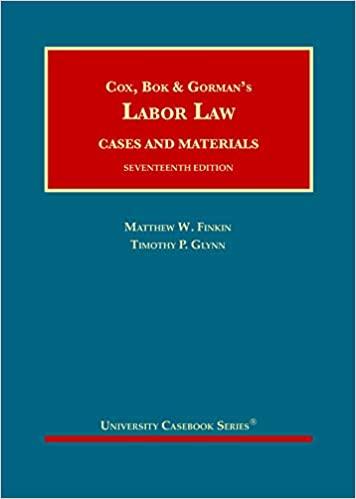Question
challenging business law questions The Board disqualified Taylor from receiving benefits pursuant to L.E. 8-1001(a)(1), which states: An individual who otherwise is eligible to receive
challenging business law questions
The Board disqualified Taylor from receiving benefits pursuant to L.E. 8-1001(a)(1), which states: "An individual who otherwise is eligible to receive benefits is disqualified from receiving benefits if the Secretary finds that unemployment results from voluntarily leaving work without good cause."[3]Yet the Board does not contend that Taylor actually "voluntarily [left] work" or quit. Rather, it contends that, based on her conduct, Taylor essentially put the employer in the position of having to terminate her because, without a County driving permit, she no longer met the criteria for employment. Thus, according to the Board, she "constructively" voluntarily left work due to the drunk driving conviction that resulted in the loss of the County driving permit that she needed for her employment.
1. Is it correct to use in the valuation of the shares of a company the "value of the real
net assets" which, according to the Institute of Accounting and Auditing (ICAC),
represents the "book value of shareholder's equity, corrected by increases or
decreasing in value which could be demonstrated, in the case of the goods, rights and
obligations of the company at the reference date?"
2. Is it correct to say that the value of the shares is the "value of the results'
capitalization" which, according to the Institute of Accounting and Auditing (ICAC)
represents "the sum of the expected future results of the company during a certain
period, discounted at the moment of the valuation?"
3. Is it true that a company creates value for its shareholders during a year if it
distributes dividends or if the quotation of the shares increases?
4. The ROE (Return on Equity) is the ratio between net income and Shareholders' equity.
The meaning of ROE is return to shareholders. Consequently, is ROE a correct
measurement of the return to shareholders?
5. Regarding the WACC that has to be applied to a project, should it be an expected
return, an opportunity cost or the average historical return on similar projects?
6. Could we assume that, as we cannot predict the future evolution of the value of shares,
a good approximation would be to consider it constant during the next five years?
7. The reasonable thing to do is to finance current assets (collections, inventories...) with
short-term debt, and fixed assets with long-term debt. Is this correct?
8. Is the market risk premium a parameter for the national economy or for the world
economy?
9. The market risk premium is the difference between the historical return on the stock
market and the return on bonds. But how many years does "historical" imply? Shall
we use the arithmetic mean or the geometric one?
10. We are valuing a company, a lot smaller than ours, in order to buy it. As that
company is a lot smaller than ours it will have no influence on the capital structure
and on the risk of the resulting company. This is the reason why I believe that the beta
and the capital structure which are relevant to the valuation of the company we are
analyzing are the ones of our company. Am I right?71
Step by Step Solution
There are 3 Steps involved in it
Step: 1

Get Instant Access to Expert-Tailored Solutions
See step-by-step solutions with expert insights and AI powered tools for academic success
Step: 2

Step: 3

Ace Your Homework with AI
Get the answers you need in no time with our AI-driven, step-by-step assistance
Get Started


